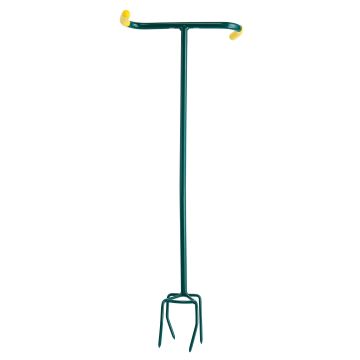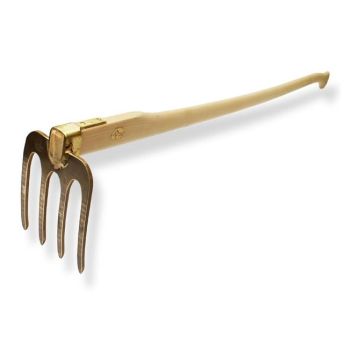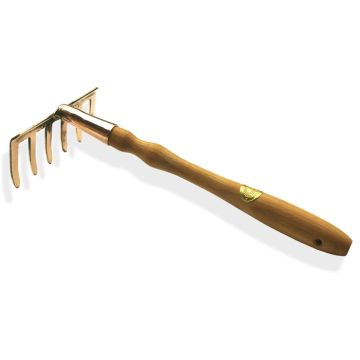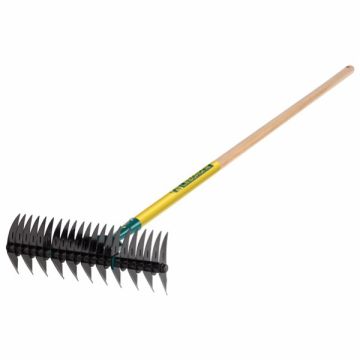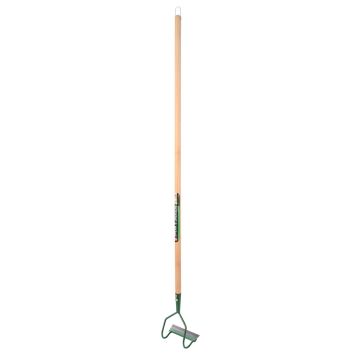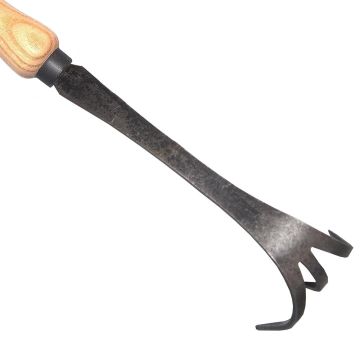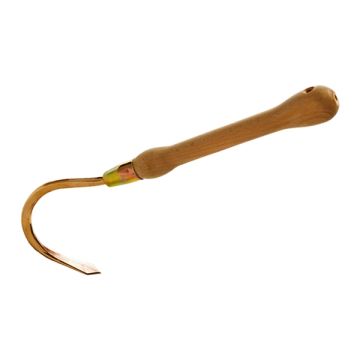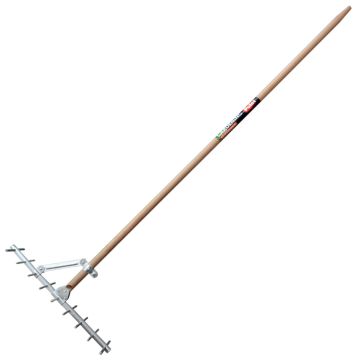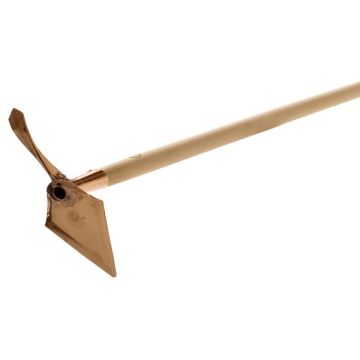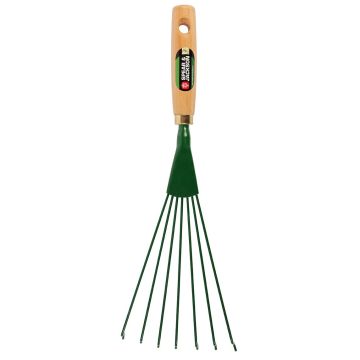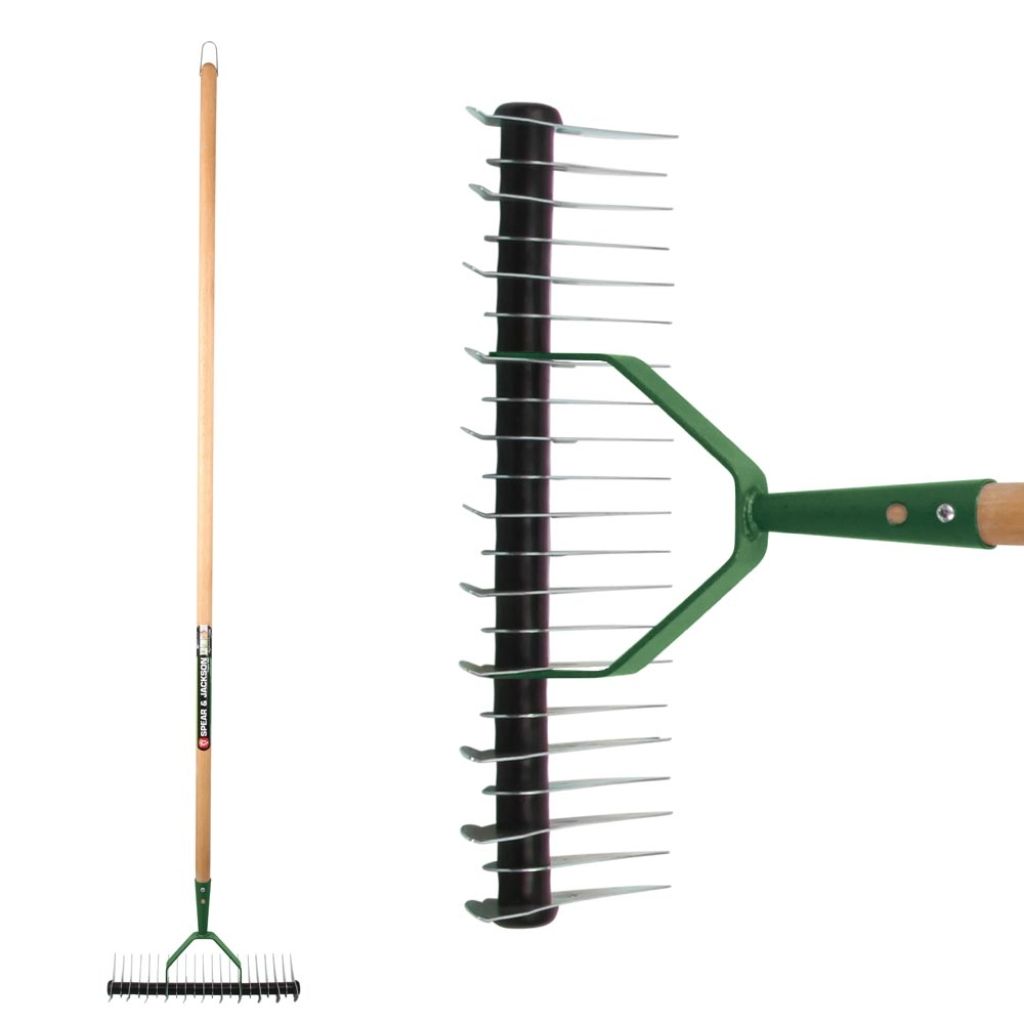

Classic Double Rake Scarifier by Spear & Jackson
Classic Double Rake Scarifier by Spear & Jackson
We guarantee the quality of our plants for a full growing cycle, and will replace at our expense any plant that fails to recover under normal climatic and planting conditions.
Oversize package: home delivery by special carrier from €6.90 per order..
Express home delivery from €8.90.
This Spear & Jackson Classic Double Sided Rake is a two-in-one garden tool that allows you to easily remove moss and other weeds from your lawn while also scratching the soil to aerate its roots. Simply flip the tool head, which has 21 long and fine teeth on one side and 11 shorter and hooked teeth on the other. A long handle made of beech wood allows the gardener to work while preserving their back. Ideal for scarifying the lawn, it will also be very useful for picking up debris scattered on the ground, such as grass clippings, dead leaves, and various waste.
Scarification is essential for maintaining the health of the lawn. Due to rain, lawn mowing, and foot traffic, the grass tends to suffocate under a layer of dry and decomposing debris that blocks light as well as the essential exchange of air and water for the grasses that make up the lawn. The grass turns yellow and eventually withers, leaving room for moss and various vigorous plants such as clover or dandelions. The classic scarifier is a garden tool whose teeth or blades pierce the surface of the soil to remove this layer. They also scratch the surface of the soil to restore the exchange of air, water, and nutrients. The scarifier generates a large amount of waste and gives the lawn a very bare appearance after use. However, this operation is beneficial and invigorating for the grass, which will quickly regenerate, multiply, and regain a lush green appearance. It is generally recommended to scarify the lawn twice a year, in spring after the last frost, and in autumn before the first frost. This operation is also essential before reseeding a heavily damaged lawn.
The manual double-sided model from Spear & Jackson fulfils this function perfectly, and its action is enhanced by the 21 long and pointed teeth that "prepare" the ground by removing most of the thatch as well as weeds, while the 11 short and hooked teeth effectively finish the job by scratching the soil. This is a sturdy manual scarifier with a head made of steel. Its "apple" handle, rounded at the end, is made of beech wood, a wood known for its strength. A galvanised hanging ring allows this tool to be hung on a nail or hook. The handle is compostable, and the metal head is recyclable.
Technical specifications:
- Total height: 12.5 cm
- Total width: 35 cm
- Total length: 164 cm
- Handle length: 150 cm
- Weight: 1.42 kg
- Beech wood handle
- Steel head
- Galvanised hanging ring.
Spear & Jackson has been selling tools for gardening, farming, and landscaping to both professionals and amateurs since 1760! Today, their range reflects all this experience by offering innovative, high-quality products suitable for a wide range of uses.
Technical features
Tips
Other Hand rakes, hand claws, and hand forks
This item has not been reviewed yet - be the first to leave a review about it.
Haven't found what you were looking for?
Hardiness is the lowest winter temperature a plant can endure without suffering serious damage or even dying. However, hardiness is affected by location (a sheltered area, such as a patio), protection (winter cover) and soil type (hardiness is improved by well-drained soil).

Photo Sharing Terms & Conditions
In order to encourage gardeners to interact and share their experiences, Promesse de fleurs offers various media enabling content to be uploaded onto its Site - in particular via the ‘Photo sharing’ module.
The User agrees to refrain from:
- Posting any content that is illegal, prejudicial, insulting, racist, inciteful to hatred, revisionist, contrary to public decency, that infringes on privacy or on the privacy rights of third parties, in particular the publicity rights of persons and goods, intellectual property rights, or the right to privacy.
- Submitting content on behalf of a third party;
- Impersonate the identity of a third party and/or publish any personal information about a third party;
In general, the User undertakes to refrain from any unethical behaviour.
All Content (in particular text, comments, files, images, photos, videos, creative works, etc.), which may be subject to property or intellectual property rights, image or other private rights, shall remain the property of the User, subject to the limited rights granted by the terms of the licence granted by Promesse de fleurs as stated below. Users are at liberty to publish or not to publish such Content on the Site, notably via the ‘Photo Sharing’ facility, and accept that this Content shall be made public and freely accessible, notably on the Internet.
Users further acknowledge, undertake to have ,and guarantee that they hold all necessary rights and permissions to publish such material on the Site, in particular with regard to the legislation in force pertaining to any privacy, property, intellectual property, image, or contractual rights, or rights of any other nature. By publishing such Content on the Site, Users acknowledge accepting full liability as publishers of the Content within the meaning of the law, and grant Promesse de fleurs, free of charge, an inclusive, worldwide licence for the said Content for the entire duration of its publication, including all reproduction, representation, up/downloading, displaying, performing, transmission, and storage rights.
Users also grant permission for their name to be linked to the Content and accept that this link may not always be made available.
By engaging in posting material, Users consent to their Content becoming automatically accessible on the Internet, in particular on other sites and/or blogs and/or web pages of the Promesse de fleurs site, including in particular social pages and the Promesse de fleurs catalogue.
Users may secure the removal of entrusted content free of charge by issuing a simple request via our contact form.
The flowering period indicated on our website applies to countries and regions located in USDA zone 8 (France, the United Kingdom, Ireland, the Netherlands, etc.)
It will vary according to where you live:
- In zones 9 to 10 (Italy, Spain, Greece, etc.), flowering will occur about 2 to 4 weeks earlier.
- In zones 6 to 7 (Germany, Poland, Slovenia, and lower mountainous regions), flowering will be delayed by 2 to 3 weeks.
- In zone 5 (Central Europe, Scandinavia), blooming will be delayed by 3 to 5 weeks.
In temperate climates, pruning of spring-flowering shrubs (forsythia, spireas, etc.) should be done just after flowering.
Pruning of summer-flowering shrubs (Indian Lilac, Perovskia, etc.) can be done in winter or spring.
In cold regions as well as with frost-sensitive plants, avoid pruning too early when severe frosts may still occur.
The planting period indicated on our website applies to countries and regions located in USDA zone 8 (France, United Kingdom, Ireland, Netherlands).
It will vary according to where you live:
- In Mediterranean zones (Marseille, Madrid, Milan, etc.), autumn and winter are the best planting periods.
- In continental zones (Strasbourg, Munich, Vienna, etc.), delay planting by 2 to 3 weeks in spring and bring it forward by 2 to 4 weeks in autumn.
- In mountainous regions (the Alps, Pyrenees, Carpathians, etc.), it is best to plant in late spring (May-June) or late summer (August-September).
The harvesting period indicated on our website applies to countries and regions in USDA zone 8 (France, England, Ireland, the Netherlands).
In colder areas (Scandinavia, Poland, Austria...) fruit and vegetable harvests are likely to be delayed by 3-4 weeks.
In warmer areas (Italy, Spain, Greece, etc.), harvesting will probably take place earlier, depending on weather conditions.
The sowing periods indicated on our website apply to countries and regions within USDA Zone 8 (France, UK, Ireland, Netherlands).
In colder areas (Scandinavia, Poland, Austria...), delay any outdoor sowing by 3-4 weeks, or sow under glass.
In warmer climes (Italy, Spain, Greece, etc.), bring outdoor sowing forward by a few weeks.

































